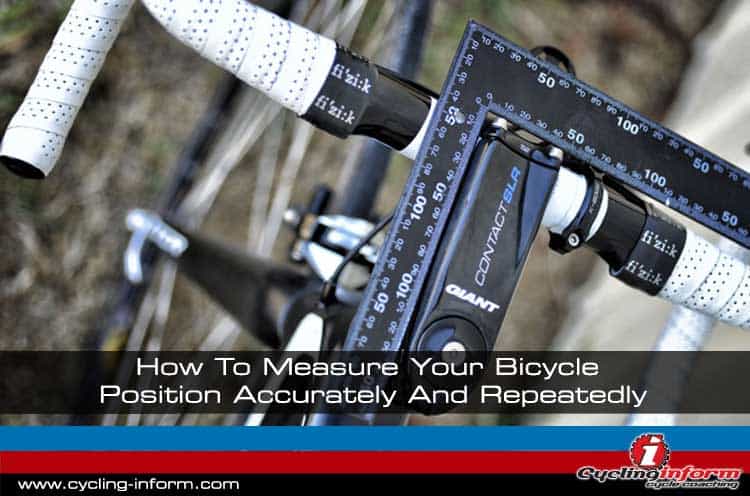This article discuss how to measure your bicycle position accurately and repeatedly so that you can transfer measurements from one bike to another and get both bikes accurately setup.
Written By Steve Hogg
Mount your bike in an indoor trainer and use a long carpenters level held between the centre of the front and rear axles to ensure that the bike is dead level. You will need to use a phone book or some other item to lift the front axle high enough to be level with the rear axle. If you don’t level the bike properly, every measurement you take will be inaccurate
Seat height
Measure the length of the flat section of your seat rail and place a marker pen dot at the half way point. Lay a 300mm steel rule along the top of your seat. Use a tape measure to measure from centre of bottom bracket to the underside of the steel rule ensuring that the measuring edge of the tape passes through the dot you have placed on the seat rail.
Seat angle relative to horizontal
Place a dial protractor (available at any hardware store) or digital level on top of your seat and read off the angle. + equals nose up; -equals nose down. If your seat has a groove or perineal cut out through the middle of it, ensure that the steel rule is laid along the edge of the seat so you are measuring from the high point at the rear of the seat to the high point at the front of the seat.
Seat setback
Hold the long carpenters’ level vertically with the edge passing through the centre of the bottom bracket. While ensuring that the bubble of the level is centered, hold a steel rule against the edge of the level and measure the distance to the nose of the seat.
Seat nose to handlebar distance
Ensure that the front wheel is pointing straight ahead. Measure from the nose of the seat to the centre of the top of the handlebar adjacent to the edge of the handlebar stem’s bar clamp. The reason you are not measuring to the centre of the stems bar clamp is because the CAD drawing on Page 5 uses the hypothetical centre of the handlebar (inside the handlebar) as an input. The parallax involved in measuring as I have described; to the centre of the bar adjacent to the edge of the bar clamp of the stem will yield the same hypothetical measurement + / – 1mm
Seat to handlebar drop
Hold the level horizontally so that one end of the level is on the seat directly above the dot on the seat rail. Use a steel rule to measure from the bottom edge of the level to the top of the handlebar adjacent to the stem bar clamp. For an mtb or 26.0 mm standard diameter road bar, add 13mm to the observed measurement. For an oversized 31.8mm mtb or road bar, add 16mm to the observed measurement. Again, my CAD program uses the hypothetical centre of the bar as an input, so adding the radius of the bar gives an accurate measurement.
Bar angle (road or bullhorn bars)
Remove your bar tape and hold the dial protractor against the underside of the rearmost section of your bar drops. A + angle means that this part of the bar runs up towards the front. A – angle means that it runs down towards the front.
Brake lever height
With bar tape removed, hold a steel rule firmly against the underside of the rear most section of your drop or bullhorn bar. Use a second steel rule to measure from the first steel rule to the bottom of the brake lever. You will have always have a gap or an overlap. A gap is a + measurement (bottom of brake lever is higher than bottom of handle bar) and an overlap (bottom of brake lever is below bottom of handlebar) is a – measurement.
Many thanks to Steve Hogg for letting us republish this.






Leave A Comment